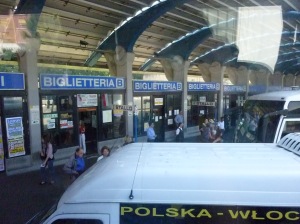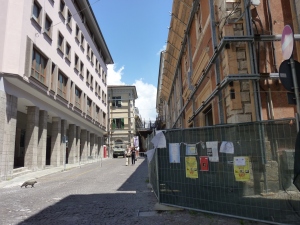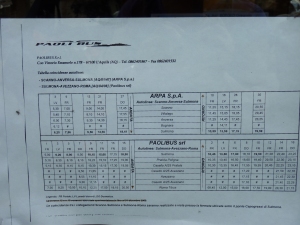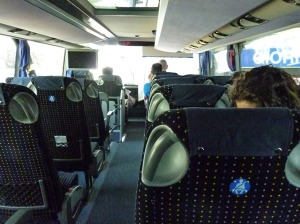
Bus station near Tibertina Train Station
I made a big mistake the day I left Rome for Anversa degli Abruzzzi. I knew I needed cash to pay the rest of my bill at Porta dei Parchi and I knew that there would be few cash points out in the country. But I did not go to a bancomat in the Roma Termini Train Station. I took the 10 to 15 minute walk from my hotel, the Domus Nova Bethlem, to the Termini Metro stop. For one euro, I took the Metro from Termini to Tiburtina, another train station. I assumed that it would be easy to find a bancomat there. But it wasn’t. In hind site, I took the metro, not the train and while the two transportation systems are connected underground, I did not go to the areas at either train station where there would be a bancomat. Eager to be on my way, I decided to go ahead and find my bus and try to change money in L’Aquila. The bus station was not easy to find. There were no signs. If I asked anyone, they just said, “Non lo so”. “I don’t know it.” I walked from the Metro stop towards the train station and then outside where I crossed streets under an overpass. Once there, the biglietteria, ticket office, was easy to find.
Excited to see the mountains, I took a seat in the upper deck of the bus to L’Aquila. The dinner at the bioagriturismo was not until eight that night. So I had time to see a little of L’Aquila before getting the next bus to Sulmona, then another to Anversa.
The bus station in L’Aquila, the Collemaggio, is at the bottom of a hill. The walk to the center of town is up the hill. At times I felt I was going nowhere. Then I found a park and then buildings. Buildings were fenced off and strapped with metal or encased in wire mesh to contain the earthquake damage. But no one was working on reconstruction. Three military personnel in camouflage hung out and chatted near their vehicle. The post office mentioned in my old guide book was cordoned off as was the church, a major tourist site. There was one man walking around taking pictures, but very little activity. I tried to use the bancomats on the side streets. One after another refused to give me cash and cited my need to contact my bank at home. My bank, however, knew I was in Italy and I had money in my account. As I started to enter another bank, an older man with a cane who was visiting with the armed guard started to talk to me. I told him that I was in Abruzzo because my grandparents were born in Calascio. He told me his daughter lived in Miami. I told him as best I could about my problem. “La macchina della banca mi dice, ‘No’.” I didn’t know the term bancomat, so I said the bank machine tells me, “No.” Perhaps I said non functiona per me. Anyway, he understood and wanted to help, but didn’t know how to help at first. I heard “non lo so” again. After I tried once more at another machine, he offered to take me to another bank. So I made a leap of faith and put my luggage in his car and he drove me to a bank away from the center. We talked about Calascio and about my upcoming trip to walk with sheep. Familiar with Porta dei Parchi, he was impressed and told me about another Abruzzo farm where they raise donkeys. Away from the center, life appeared suburban and normal. The bank machine here gave me money! I returned to the car proclaiming “Va bene! Va bene! Grazie mille!” My first experience with the Abruzzese proved what I had heard and read. The Abruzzese are strong and gentle. My fatherly friend drove me to the bus station and I thanked him profusely again.

Near the center of L'Aquila
The next bus took me through the mountains to Sulmona. I followed the route on a map. I knew that I traveled close to Calascio, but could not quite see it from the road. I asked the bus driver where I should get off for the bus to Anversa degli Abruzzi. He motioned for me to stay on the bus as he drove through the town center. At the outskirts of town, he told me to buy a ticket at the small kiosk and wait across the street for the bus. But the kiosk was closed and there was no other place to buy a ticket. A driver waited with a small bus, the size of a van, and I asked him where to buy a ticket. “Non, lo so.” Where to get the bus to Anversa. “Non lo so.” I tried to ask others, but there was no one to ask. I was near a hospital and a parking lot. It was mid day, hot and sunny, and most people relax during the mid day break. Another bus finally arrived and I asked the same questions. “Non lo so.” Finally this bus driver took me back to the center of town without a ticket and dropped me off at a park. He told me to buy a ticket at the Tabacchi and wait for the bus on the other side of the park.
As I pulled my luggage across the park, gravel walkways clogged my luggage wheels and had to lift the luggage. Finally I made it to the other side and walked towards the shops. The tabaccaio or tobacconist told me the time for the bus and that I should wait on the opposite side of the park. I had enough time for a gelato from a shop near the park. For one euro, less than half the price in Rome, the sales clerk piled the gelato into a cup for me. As I crossed the park, I remembered Elizabeth Gilbert’s favorite Italian word in Eat,Pray, Love: “attraversiamo”, “let’s cross over”. I was not thrilled to attraverso again. I stood waiting for the bus and although early, was determined not to move until the bus arrived.
After fifteen minutes of waiting, more people arrived. I told a young man where I was going. He told me to wait on the other side of the park. My bus going toward Scanno left from the other side. I had no choice but attraversare il parco di nuovo and fast. I cursed the tabaccaio under my breath and cursed myself for not listening to the bus driver. A young man in this line confirmed that I was indeed in the right line. He was returning to Scanno from college. With a dreamy look in his eyes, he insisted that I should go to Scanno where I would find the most beautiful mountains. Although I tried to tell him that I would get to Scanno while walking with the sheep, he seemed disappointed that I would get off the bus before seeing Scanno. The bus drove through Sulmona and into the beautiful mountains. Lo so. Lo so.

Park in center of Sulmona







